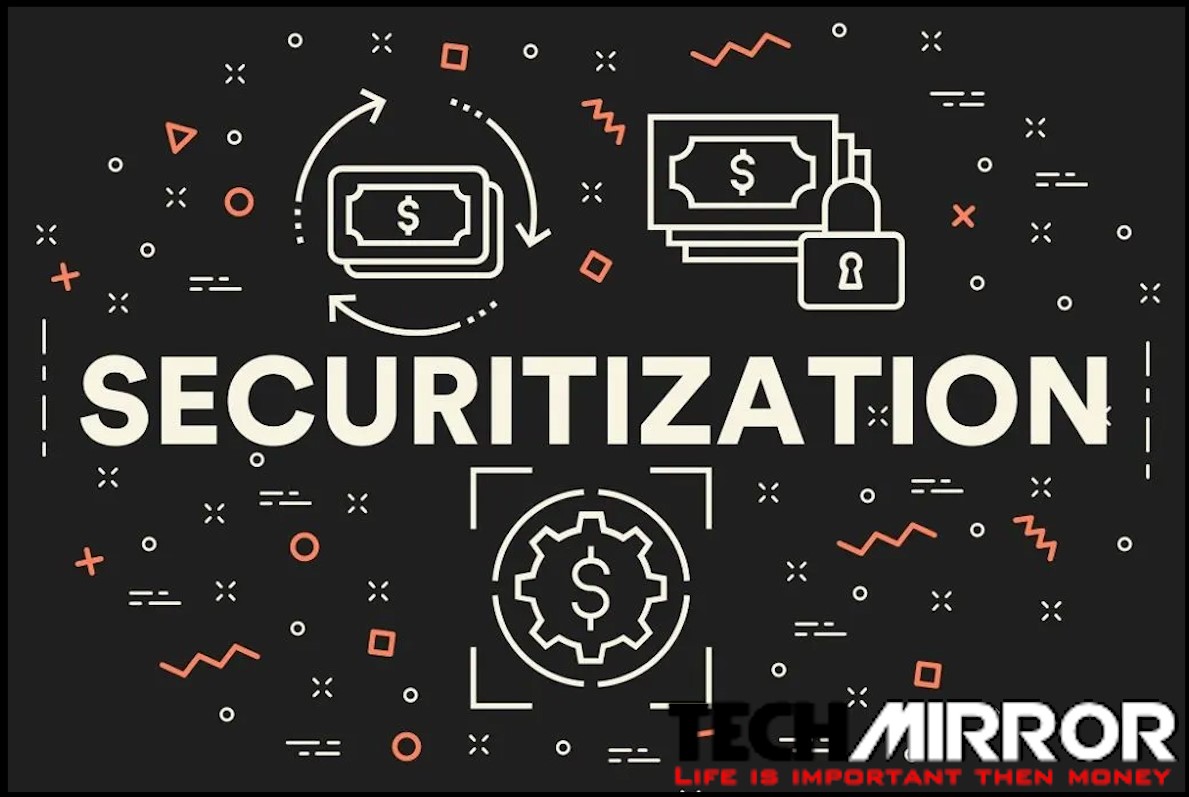Securitization is the financial practice of pooling various types of contractual debt such as residential mortgages, commercial mortgages, auto loans or credit card debt obligations (or other non-debt assets which generate receivables) and selling their related cash flows to third party investors as securities, which may be described as bonds, pass-through securities, or collateralized debt obligations (CDOs). Investors are repaid from the principal and interest cash flows collected from the underlying debt and redistributed through the capital structure of the new financing. Securities backed by mortgage receivables are called mortgage-backed securities (MBS), while those backed by other types of receivables are asset-backed securities (ABS).
What Is Securitization?
A security is a tradable financial product. It takes its value from the market and from the underlying properties that it represents. Stocks are the classic example of a security. They can be represented by a stock certificate, but a share of stock is not a tangible thing. It’s value is based on the company it represents and what other traders on the open market will pay for it.
Securitization is the process of creating tradable securities that are backed by and based on groups of existing assets. As a category this type of product is called an asset-backed security, and any individual product is typically named after the underlying assets. For example, a security backed by auto loans might be called an auto-backed security.
Most asset-backed securities are based on debt. Popular products include securities based on mortgages, student loans and even consumer debt. This is not strictly necessary. Any asset with financial value can be turned into a security. However, debt is overwhelmingly the most common form of asset-backed security because of how it generates profit.
Securitization uses pools of assets to create each new product. For example, when a bank creates a mortgage-backed security it will use a large number of mortgages. This portfolio of assets is then sold by shares like any other portfolio or fund-based product. This distinguishes securitized assets from directly purchasing the underlying asset. If an investor wanted, they could simply buy the debt of a single mortgage. By purchasing a share of a mortgage-backed security they purchase a portion of several mortgages all at once.
Typically securitization will pool large numbers of an underlying asset. For example, in the case of mortgage-backed securities, a bank may package hundreds or thousands of individual mortgages into a single portfolio.
Defining Securitization and Assets
Securitization is the process of turning assets into securities. More specifically, specific assets are pooled together and repackaged as interest-bearing securities. Securities are financial or investment vehicles that are bought and sold in financial markets similar to how stocks and bonds are traded. The purchasers of the new, repackaged interest-bearing securities receive interest and principal payments.
Let’s also define assets. Assets can be converted into cash, some easier and quicker than others. An asset that can be converted into cash quickly is called a liquid asset. An asset that takes longer to convert to cash and will likely sell for a price lower than market value is called an illiquid asset.
For example, a money market account is an account at a bank used to store cash. It usually pays a small rate of interest based on the amount of money on deposit in the account. If the owner of the account wants to withdraw all or a portion of the money, he can simply use a withdrawal form at the bank to take money out immediately. A money market account is an example of a liquid asset.
However, if a person who owns a home decides to sell the house, it could take days or months before the house sells. The owner needs to put the house up for sale, advertise or use a real estate agent, and find a buyer for the house. Once the owner finds a buyer willing to purchase the home, it’s not guaranteed that the owner will receive the full value of the home, and it can take days or even months to complete the transaction. A house is an example of an illiquid asset.
From the bank’s perspective, a mortgage loan is considered an asset because the bank receives interest and principal payments from the borrower each month for a specific length of time (usually between 10 to 30 years). However, the mortgage asset carried on the bank’s balance sheet is considered an illiquid asset because the mortgage is tied to the borrower’s home, which is also an illiquid asset.
How Does Securitization Work?
Securities may be bundled together according to their term, interest rate, credit rating, or type of loan. For example, an asset-backed security may be created by bundling long-term loans. Another security may be created by packaging together accounts receivable.
Once the financial instruments are bundled together, they will often be divided into separate securities with varying degrees of risk. This process of dividing the securities by risk is called subordination, and these risk segments are called tranches.
The securities with the highest risk will pay the highest rate of interest and provide the highest expected return, while the lower risk slices will provide lower rates of interest.
Types of Asset-Backed Securities
Securitization can create many different types of asset-backed securities. Often, a distinction is made between asset-backed securities backed by pools of mortgages and other asset-backed securities created from other types of loans.
Mortgage-Backed Securities
Mortgage-backed securities, or MBS, are a specific type of asset-backed security created by packaging together real estate loans. The investor’s return comes from the payments on the underlying mortgage. The source of risk in mortgage-backed securities is the possibility that the borrowers won’t repay their loans.
Pros and Cons of Securitization
Pros
- Provides liquidity to financial institutions
- Gives investors access to new investments
- Lowers financing cost for institutions
Cons
- Investors may not fully understand the risks
- May cause institutions to make riskier loans
Pros Explained
Securitization can create liquidity for financial institutions because they can free up assets on their balance sheets and raise new capital when those assets are packaged and sold. This allows them to make loans at a greater scale. Investors also gain access to investments that they otherwise may not be able to hold directly without securitization.
Cons Explained
There are some drawbacks to securitization as well. Investors may not always understand the risk of investing in asset-backed securities, and may experience unexpected losses. During the subprime mortgage crisis, many investors were exposed to greater default risk than they realized, because assets that were below investment grade were given investment-grade ratings, often AAA, after they were securitized.
Securitization has also been said to create a moral hazard in the loan origination process. If the institution that originates the loan does not plan to keep it, but plans to transfer the liability through securitization, then it may decide to make riskier loans that it otherwise would, because the risk of default is passed on to the investors.
Drawbacks of securitization
With the subprime mortgage crisis and the ensuing crisis of confidence, the securitization market is losing steam, and certain segments, particularly those concerning the most complex products, have come to a complete standstill. ABS, which used to be a real “El Dorado” for investors, now fall within the “toxic” asset category. What happened? It is not really within the scope of our work at fimarkets to delve into economic analyses.
Information asymmetry
In reality, the complexity of the different types of securities is a disadvantage because it leads to what is known as “information asymmetry.” In other words, the issuer of the securities knows much more about what he is really selling than the buyer (investor) does. As long as the securities issued behave as indicated in the brochure, all is well and nobody asks any questions. But as soon as problems begin to arise for certain types of securities, people become suspicious of any product falling within that category – since you really need to be an expert to be able to evaluate a securitization program –and suddenly nobody wants to buy them anymore. Akerlof first described this mechanism in terms of the used-car market (“The market for Lemons”). In this regard, the credit rating agencies have received a great deal of blame for having been too generous in awarding “AAA” ratings, but the real problem is the loss of confidence that spreads throughout an entire asset class to a completely irrational degree.
Moral hazard
Moreover, securitization, as we have seen, offers banks an opportunity to trim their balance sheets, which makes it easier for them to fulfill their regulatory obligations. They have jumped at the opportunity. At the same time, they have veered away from their basic function, the cornerstone of which is to accurately assess credit risk. With the extension of credit becoming increasingly easy, credit agencies have become less stringent with regard to the quality of the final borrowers. This is referred to as “moral hazard.” The banks have moved away from their role of financing the economy, seeking instead to assume (fortunately, not completely) a purely intermediary role in an economy that seems to have become completely “marketized.” Today, the situation is reaching its limits.
Real-World Examples of Securitization
Charles Schwab offers investors three types of mortgage-backed securities called specialty products. All the mortgages underlying these products are backed by government-sponsored enterprises (GSEs). This secure backing makes these products among the better-quality instruments of their kind. The MBSs include those offered by:
- Government National Mortgage Association (GNMA): The U.S. government backs bonds guaranteed by Ginnie Mae. GNMA does not purchase, package, or sell mortgages, but does guarantee their principal and interest payments.
- Federal National Mortgage Association (FNMA): Fannie Mae purchases mortgages from lenders, then packages them into bonds and resells them to investors. These bonds are guaranteed solely by Fannie Mae and are not direct obligations of the U.S. government. FNMA products carry credit risk.
- Federal Home Loan Mortgage Corporation (FHLMC): Freddie Mac purchases mortgages from lenders, then packages them into bonds and resells them to investors. These bonds are guaranteed solely by Freddie Mac and are not direct obligations of the U.S. government. FHLMC products carry credit risk.
Takeaway
Instead of selling individual appetizers, some restaurants sell a combo that groups together several popular options. The combo basket can be a safer bet for diners. If you don’t like one of the choices, you’ve got others to eat. Similarly, securitization is the practice of bundling different assets together into a diversified security (or a combo basket) to sell to investors. It can be safer for investors than buying individual mortgages, as they don’t lose all of their money if one borrower defaults. Still, investing in asset-backed securities comes with risk, and returns are not guaranteed.




